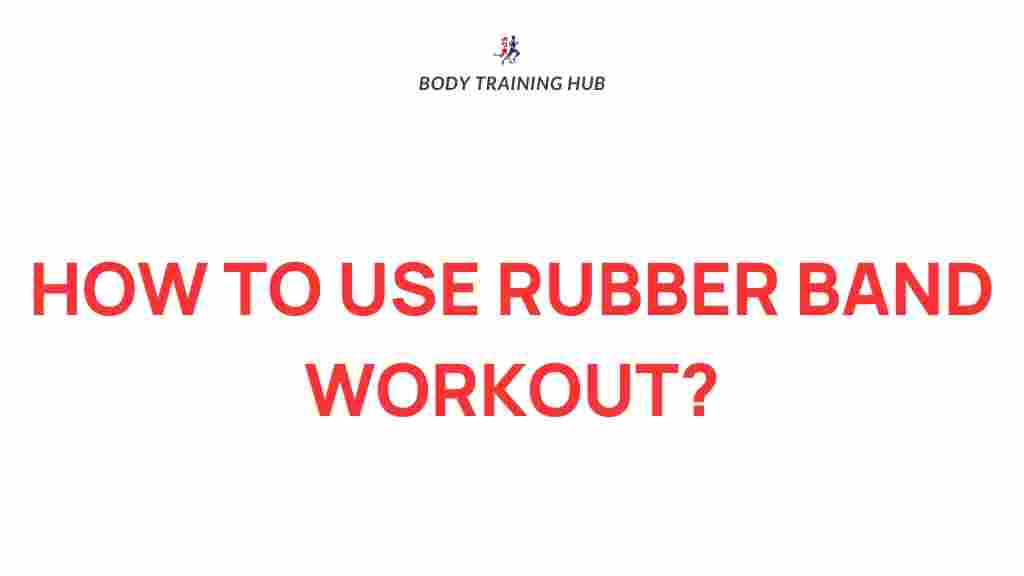Unlock the Secrets of Rubber Band Fitness: The Ultimate Rubber Band Workout
In today’s fast-paced world, finding an effective and convenient way to stay fit is essential. Whether you’re a fitness enthusiast or a beginner, incorporating a rubber band workout into your routine can be a game-changer. This article will explore the benefits of resistance training with rubber bands, how to create a comprehensive home workout plan, and tips for maximizing your fitness journey.
What is a Rubber Band Workout?
A rubber band workout utilizes resistance bands as a form of fitness equipment to enhance strength training. These versatile bands come in various resistance levels, making them suitable for individuals of all fitness levels. Resistance training with rubber bands helps to build muscle, increase flexibility, and improve overall fitness without the need for bulky gym equipment.
Benefits of Rubber Band Workouts
Rubber bands are an excellent addition to any fitness routine. Here are some of the key benefits:
- Portability: Rubber bands are lightweight and easy to transport, making them perfect for home workouts or traveling.
- Versatility: They can be used for a variety of exercises targeting different muscle groups.
- Cost-effective: Rubber bands are an affordable fitness equipment option compared to traditional weights.
- Joint-friendly: Resistance bands provide a low-impact way to perform strength training, reducing the risk of injury.
- Progressive Resistance: As you get stronger, you can easily switch to bands with higher resistance.
Getting Started with Rubber Band Workouts
Before diving into your rubber band workout, it’s essential to familiarize yourself with the different types of bands available:
- Loop Bands: These bands form a continuous loop and are great for leg and glute exercises.
- Tube Bands: These bands have handles and are excellent for upper body workouts.
- Therapy Bands: These are often used in physical therapy and are ideal for gentle strength training.
When selecting a band, consider your fitness level and the types of exercises you plan to perform. Starting with a medium resistance band is a good option for most beginners.
Creating Your Rubber Band Workout Routine
Here’s a step-by-step guide to crafting a rubber band workout that targets all major muscle groups:
Step 1: Warm-Up
Always start with a warm-up to prepare your muscles for the workout. Consider dynamic stretches or light cardio for about 5-10 minutes.
Step 2: Full-Body Workout Plan
Here’s a sample rubber band workout routine:
- Squats with Resistance Bands: Stand on the band with feet shoulder-width apart and hold the handles at shoulder height. Perform squats while keeping your chest up.
- Chest Press: Anchor the band behind you and press forward while standing or sitting. This targets your chest and triceps.
- Seated Rows: Sit on the floor with legs extended, loop the band around your feet, and pull back towards your torso. This exercise works your back muscles.
- Standing Bicep Curls: Stand on the band and curl the handles towards your shoulders, focusing on your biceps.
- Tricep Extensions: Stand on the band, hold the handles above your head, and extend your arms upward.
Perform 10-15 repetitions of each exercise for 2-3 sets, resting for 30-60 seconds between sets.
Step 3: Cool Down
Finish your workout with a cool down, including static stretches to improve flexibility and reduce muscle soreness.
Incorporating Rubber Band Workouts into Your Routine
To maximize the benefits of your rubber band workout, consider the following tips:
- Consistency: Aim to work out at least 2-3 times a week to see progress.
- Progression: Gradually increase the resistance or the number of repetitions as you become stronger.
- Variety: Incorporate different exercises to target various muscle groups and prevent boredom.
Troubleshooting Common Issues
As you embark on your rubber band fitness journey, you may encounter some challenges. Here are some common issues and how to overcome them:
- Band Slipping: Ensure the band is securely anchored or adjust your grip to maintain control.
- Insufficient Resistance: If the band feels too easy, switch to a thicker band or double up on bands for added resistance.
- Improper Form: Focus on maintaining proper posture during exercises to avoid injury. Consider watching instructional videos or consulting a trainer.
Additional Resources for Rubber Band Fitness
For more tips and workout ideas, check out this comprehensive guide to resistance training. It covers a wide range of exercises and techniques to enhance your fitness journey.
Conclusion
Rubber band workouts are an excellent way to incorporate resistance training into your fitness routine. They offer a versatile, portable, and effective method for strength training that can be done at home or on the go. By following the tips and routines outlined in this article, you can unlock the secrets of rubber band fitness and achieve your fitness goals.
Remember, the key to success in any workout plan is consistency and progression. Stay committed, and you will see the benefits of your rubber band workout in no time!
For more fitness tips, be sure to check out our blog for the latest information on home workouts and fitness equipment.
This article is in the category Strength & Recovery and created by BodyTraining Team
